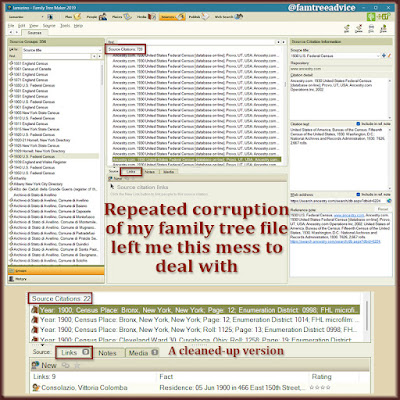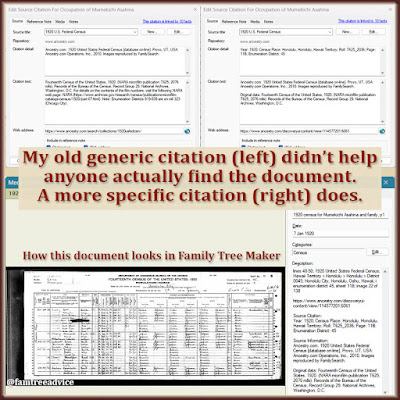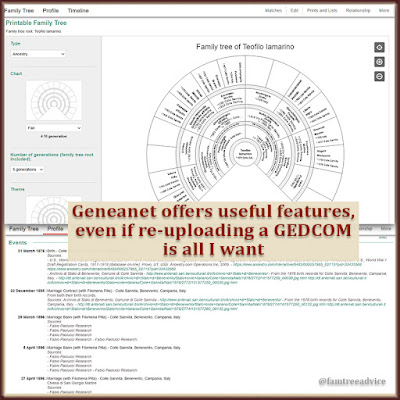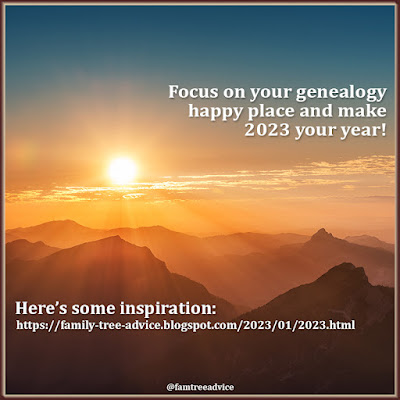Last week I had to swear off synchronizing my Family Tree Maker file with my tree on Ancestry. (See "A Major Family Tree Change to Fix an Ongoing Problem.") Too many failed syncs made it impossible to go on. In facts, those failed syncs did more damage to my desktop tree than I knew. I'm determined to see this as an opportunity to improve my family tree.
During my corporate life, I always hated when a boss would call a pain-in-the-butt project an "opportunity." An opportunity to improve our website. An opportunity to improve our support for the sales team. It wasn't an opportunity for workers like me who had countless hours of grunt work ahead of us. You can't sugar-coat that burden.
Yet here I am calling this problem an opportunity to improve the source citations in my family tree.
 |
| Failed syncs of my Family Tree Maker file left me with tons of splintered and unlinked source citations. |
There were 2 things I now know happened to my desktop tree with each failed sync:
- My tree no longer recognized some addresses. This was plain to see and easy enough to fix. I viewed each bad address in the Places tab of Family Tree Maker and made a few clicks. If you use FTM, see the company's instructions for standardizing locations.
- My tree split my shared source citations into a bunch of identical citations. That's because an Ancestry tree sees each citation differently than FTM. Many citations weren't linked to anyone at all. These may be leftovers from people I deleted without first deleting their citations. Thousands of duplicate citations were increasing my tree's file size dramatically.
I've had a project on my radar to update citations for documents found on the Italian Antenati portal. The links in my old citations don't work anymore because of a huge change to the Antenati website. Spelling out the town, year, and document number would make each record findable—even if that website changes the links again. But it's a huge task.
Develop a Format and Stick to It
When I saw the mess my U.S., Canada, and U.K. source citations were in, I knew what I had to do. It was time to improve my oldest citations and make them match my current style.
For example, I'm looking at the 1920 U.S. Federal Census document image for my husband's ancestor. These days I like to add a ton of detail to the document image's description. But this early find says only:
https://www.ancestry.com/interactive/6061/4442141_01017/114577201
That's pretty helpful, but my newer format is better. The citation should say this:
https://www.ancestry.com/discoveryui-content/view/114577201:6061
Source Citation:
Year: 1920; Census Place: Honolulu, Honolulu, Hawaii Territory; Roll: T625_2036; Page: 11B; Enumeration District: 45
Source Information:
Ancestry.com. 1920 United States Federal Census [database on-line]. Provo, UT, USA: Ancestry.com Operations, Inc., 2010. Images reproduced by FamilySearch.
Original data: Fourteenth Census of the United States, 1920. (NARA microfilm publication T625, 2076 rolls). Records of the Bureau of the Census, Record Group 29. National Archives, Washington, D.C.
To be clear, I'm putting that extra long citation into the properties of a document image. When I drag the image into FTM, all that info comes along for the ride. Then I use everything from the URL down to populate the source citation for this document's facts. Let me dissect that format so you can follow my logic.
- lines 48-50 — This tells me and anyone who sees my copy of this document on Ancestry where to look on the page. This goes for ship manifests, too.
- 1920 United States Federal Census — This is the name of the record collection that has this document.
- Hawaii Territory > Honolulu > Honolulu > District 0045 — When you look at the document on Ancestry, this is the detail shown at the top of the screen.
- Honolulu City, Honolulu, Oahu, Hawaii, enumeration district 45, sheet 11B — These details can help locate this document on or off Ancestry.
- image 22 of 138 — This tells you exactly which image to go to in the collection on Ancestry.
- https://www.ancestry.com/discoveryui-content/view/114577201:6061 — The URL points to this record (not the document image) on Ancestry. This URL also contains the Source Citation and Source Information I add beneath the URL. I used to link to the image on Ancestry.com. But it's more useful to link to the record page.
This style includes enough detail so anyone can find the image—even without a link or an Ancestry account. And I attach the image to the Media tab of the citation itself. That's something I didn't know was possible until a few years ago.
Once I finish a citation, I copy and paste it to each family member in the census. And I can delete the duplicate copies each failed sync generated.
How to Check All Your Source Citations
I started this process by looking at the Sources tab in Family Tree Maker. There's a long list of all my sources on the left, in alpha-numeric order. Each one contains lots and lots of citations I can improve and share with each family member. In the end I'll have a neat, perfect list of citations with no duplicates.
 |
| As long as there's a mess to clean up, why not make the source citations in my family tree live up to my standards? |
Each time I delete a ton of duplicate or unlinked citations, my tree's file size gets smaller. Amazingly, my FTM file went from 4 gigabytes on my failing laptop to 360 megabytes on my new computer. I'm still in shock.
I look forward to uploading my improved, streamlined GEDCOM file to Geneanet.org. I'll overwrite the version that's there, rather than synchronize it. I want anyone who sees that tree to find usable links to every bit of evidence I have for a person.
Once I finish my long list of U.S., Canada, and U.K. citations, I'll figure out how to tackle those obsolete Antenati citations.
Even if you haven't suffered damage to your family tree, revisiting your earliest citations is worthwhile. Have a look at them and see how many you're happy with. Bringing them all up to your standard will fortify your family tree.






